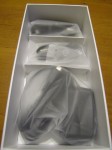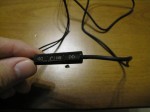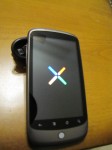After having seen the Nexus One in the flesh prior to it being launched, I knew that I would have to order one as soon as it officially launched. As soon as the online store went live during the presentation, I placed an order for the unlocked version, as my T-Mobile family plan doesn’t qualify for the subsidized version. Read on for more thoughts on the ordering and delivery process, some unboxing photos, and some initial thoughts on the Nexus One hardware and Android 2.1.
The Ordering Process
The Google launch event was not quite a rock star event like an Apple keynote, but the event gave enough details around the Nexus One to help potential buyers decide if they were interested in it. I think that a lot of the information had been leaked prior to the launch event, but there was still some new information shown in the presentation. Honestly, there wasn’t a lot of energy in the presentation, but it was still interesting to watch. I found it interesting that they had not only HTC present, but had Motorola show up for the Q&A session (albeit late). Thanks to Francis, I was able to see a stream of the event.
As soon as the website went live, I went to place an order. First surprise was that in addition to the unsubsidized and T-Mobile subsidized version, there was information on the Verizon version coming soon (along with details about buying a Droid now), as well as listing the Vodafone version. The rest of the process was fairly standard: engraving, shipping choice (default was free Fedex overnight!), and paying.
Paying was interesting because Google required a Google Checkout account. This makes sense because you currently need a Google Checkout account to purchase applications in the Android Market. Since I already had an account, the process was just a single click. I immediately received a confirmation email and had up to 15 minutes to cancel the order. Later that evening, I received an email stating my order had shipped and would in in the next day. Overall, the process was streamlined and just what you would expect.
Initial Thoughts
Overall, the Nexus One is very well-built. I have seen some comments about issues with the hardware buttons on the front of the device, but I haven’t had any issues using the buttons. The size and weight of the Nexus One remind me a lot of the iPhone, only with a removable battery. The power button on top is a bit easy to accidentally hit. The processor in this phone makes it FAST.
The specifications on the phone can be found easily online, but some highlights are:
- 800×480 OLED screen
- 1 GHz processor
- 802.11 b/g/n Wifi
- 5 MP autofocus camera with LED flash
- 4 GB Micro SD card, up to 32 GB
In fact, everyone who has seen the phone (and most of them are iPhone 3G/3GS users) are amazed at how fast the whole system feels and how nice the Nexus One sits in the hand. Very iPhone-like.
On the software side, there have been a lot of improvements over Android 1.6, which is currently installed on my T-Mobile myTouch 3G. While Motorola Droid users have been taking advantage of the Android 2.0 features already, I had not experienced these improvements first-hand.
Screen
The OLED glass screen is simply amazing and takes up almost the whole front. It has a black border around it under the glass. Screen is very vivid and responsive. Since it is slightly larger than the myTouch 3G and even the iPhone, it makes typing on-screen easier.
On-Screen Keyboard
Android 2.x implements multi-touch in the keyboard. It’s in the API, but not many other apps support it yet. However, the keyboard does and is more usable than the myTouch is. I use both thumbs to type and the 1.6 OS can’t keep up with me. The 2.1 does, for the most part. The keys are still feel smaller than the iPhone, but overall, it’s a much improved on-screen keyboard. Giving up the physical keyboard for the thinness of the device, I think it would be okay to use most of the time, though I’d still prefer a hardware keyboard as an option.
Speed
It’s fast. Seriously fast. WOW fast. Faster than the iPhone 3GS. It has the faster processor in it, so obviously on paper it should be faster, but they’ve optimized the OS significantly. It’s quite usable now. VERY fast, NO lag. Hitting the home screen works instantly. Switching apps is instantaneous. UI animations throughout that make the device look sexy with nice, subtle transitions.
I run several apps in the background and it was still snappy. Basically, what I had hoped for in Android all along. Also, the built-in processes take up less processor power, so the code has been more optimized. For example, at any given time, I am running:
- Gmail/Calendar/Contacts Sync
- Browser with a few tabs
- Yammer
- Twidroid Pro
- Google Talk
- Music Player
- Remember the Milk
- Google Voice
And there is still no lag or slowdown. Not so with the myTouch 3G.
Build / Form Factor
The device is solid, No creaking, flexing, etc. Very well-built. Battery cover doesn’t come off easily (in a good way). Won’t have the same battery cover issue as the Droid, that’s for sure. It is thinner than the iPhone but still has a removable battery.
Buttons and Inputs
Button layout is different. Like the Droid, now has the “back” and “home” buttons swapped compared to the myTouch 3G. The Nexus One layout is:
Back, Menu, Home, Search
Physical send/end keys gone, but on/off switch is on the top. Trackball is able to produce multiple colors (like Sidekicks) for alerts and notifications. It’s half in the device, but larger. So, think of it as the size of the myTouch trackball, but half sticking out (like the G1). In other words, it doesn’t have the same recessed carved out section around the trackball like the myTouch.
Other Nice Features
- Voice Recognition – Built-in to every text entry field! You can click in any field say something, and the data is analyzed on Google’s servers, and then input that data to the field.
- Camera – A 5 megapixel with an LED flash. The bezel around the camera sticks up a bit from the back, and is beside the speakerphone port. So the device sits mostly flat on its back, but is raised slightly at the top (where the camera is top/center) to allow for some clearance for the speakerphone.
- Mail app / multiple accounts / Exchange – You can now have multiple accounts for Gmail in the mail program, as well as on the device (and Exchange as well). So if you want to sync your calendar with one account and contacts and other stuff with others, that’s possible now. This is a standard Android 2.x feature, but I dig it.
In addition to the fast 1 GHz processor, the software has been optimized as well. There is no longer any lag in loading any applications, even with several programs running in the background. The camera app launched faster in Android 1.6 but still had a bit of slowness, but now it loads almost instantly. I really appreciate some of the new and updated widgets, including the Power widget, which allows for quick toggling of Wifi, Bluetooth, GPS, screen brightness, and sync. The live wallpapers are cool to demo the phone to someone, but don’t use them as they waste battery life.
Speaking of battery life, I was able to use the phone today for a little over 16 hours. However, today was a bit unusual because I listened to podcasts using the speaker for quite a while and did a lot of demoing of the phone. So in normal usage, I expect it would last longer. Normally with the myTouch 3G, I usually hit 20% battery by around 12 – 14 hours of usage. So, considering the much faster processor, I don’t notice much difference in actual battery life.
Conclusion
To me, this is the first Android device that could truly be replacement for the iPhone for many. Some won’t like the UI of Android, but a lot of people who have had iPhones like the UI on the Nexus One. I feel it is the first Android device from both a hardware and software perspective that could be used in place of an iPhone. This is what the original Android devices should have been.






















I…so…want…one! Sounds awesome.
Great info Thomas! I have to say that I’ve been decreasingly excited by the Nexus One after the initial inundation of reviews and opinions. The info you’ve been sharing, coupled with this post swayed me. Ordered the N1 and gonna test it out. Like you’ve said before, the only way to really know for sure is to use it hands on. 😀
@Joel – I think you’ll love it when you get it. The only thing that could be better is a similar version with a slide-out keyboard. Can’t wait until you get one!
@Jason – I can tell you that everyone I have shown it to are impressed. Am eager to hear your thoughts and impressions as well. And, if you don’t like it, you could always sell it to Joel. 😉